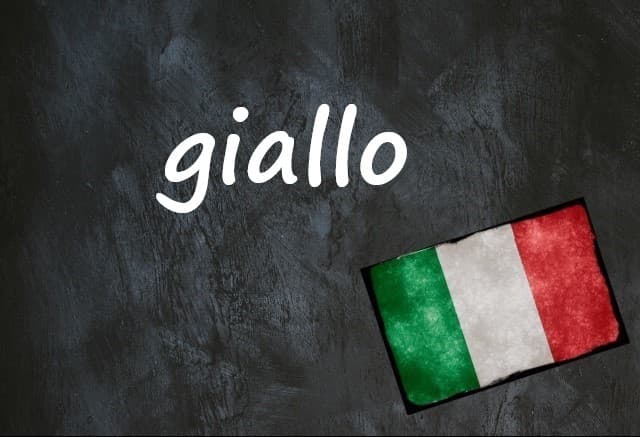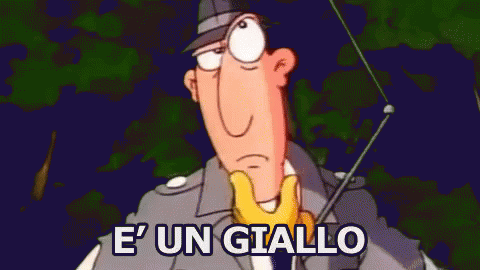Italian word of the day: 'Giallo'

In Italy, the colour yellow means more than you think.
Giallo ('yellow') is a colour we've seen a lot of lately, thanks to France's gilet gialli, or 'yellow vests'.
But in fact, in Italy the word giallo is rarely out of the headlines.
That's because the word is a byword for a certain type of mystery, thanks to a popular series of detective stories – usually quite short books in the pulp genre, often with unbelievable twists – that were published in the early 20th century between distinctive yellow covers.
Un giallo is still used as shorthand for 'a detective story' today.

A contemporary libro giallo, both literally and figuratively.
But in Italian newspaper-speak, giallo can refer to anything vaguely mysterious: like 'riddle' or 'enigma'.
Most often you'll see it accompanying crime stories, particularly when the culprit isn't yet known.

'Vigne Nuovo mystery solved: poisoned by girlfriend with drink and drugs, she's arrested for murder': a recent crime story.
It's also used to spice up the fairly mundane. Local residents report hearing an unexplained noise? It's un giallo. S
ports reporters aren't sure what time a football match starts? Un giallo again.

'Ahead of Lazio-Roma, the time of the derby is a mystery: decision expected today': one recent sports headline.
Headline writers are the people most prone to use the word this way: in everyday speech, you're more likely to hear giallo (pronounced "jial-lo") in all the places you'd expect it – on a football pitch (un cartellino giallo is a 'yellow card'), inside eggs (il giallo dell'uovo – 'egg yolk') and all over the phone book (le pagine gialle – 'Yellow Pages').
But there's one extra place it turns up: on traffic lights, which for some reason in Italy turn giallo instead of orange or amber.
Why? It's a mystery.

Do you have a favourite Italian word you'd like us to feature? If so, please email us with your suggestion.
Comments
See Also
Giallo ('yellow') is a colour we've seen a lot of lately, thanks to France's gilet gialli, or 'yellow vests'.
But in fact, in Italy the word giallo is rarely out of the headlines.
That's because the word is a byword for a certain type of mystery, thanks to a popular series of detective stories – usually quite short books in the pulp genre, often with unbelievable twists – that were published in the early 20th century between distinctive yellow covers.
Un giallo is still used as shorthand for 'a detective story' today.

A contemporary libro giallo, both literally and figuratively.
But in Italian newspaper-speak, giallo can refer to anything vaguely mysterious: like 'riddle' or 'enigma'.
Most often you'll see it accompanying crime stories, particularly when the culprit isn't yet known.

'Vigne Nuovo mystery solved: poisoned by girlfriend with drink and drugs, she's arrested for murder': a recent crime story.
It's also used to spice up the fairly mundane. Local residents report hearing an unexplained noise? It's un giallo. S
ports reporters aren't sure what time a football match starts? Un giallo again.

'Ahead of Lazio-Roma, the time of the derby is a mystery: decision expected today': one recent sports headline.
Headline writers are the people most prone to use the word this way: in everyday speech, you're more likely to hear giallo (pronounced "jial-lo") in all the places you'd expect it – on a football pitch (un cartellino giallo is a 'yellow card'), inside eggs (il giallo dell'uovo – 'egg yolk') and all over the phone book (le pagine gialle – 'Yellow Pages').
But there's one extra place it turns up: on traffic lights, which for some reason in Italy turn giallo instead of orange or amber.
Why? It's a mystery.

Do you have a favourite Italian word you'd like us to feature? If so, please email us with your suggestion.

Join the conversation in our comments section below. Share your own views and experience and if you have a question or suggestion for our journalists then email us at [email protected].
Please keep comments civil, constructive and on topic – and make sure to read our terms of use before getting involved.
Please log in here to leave a comment.